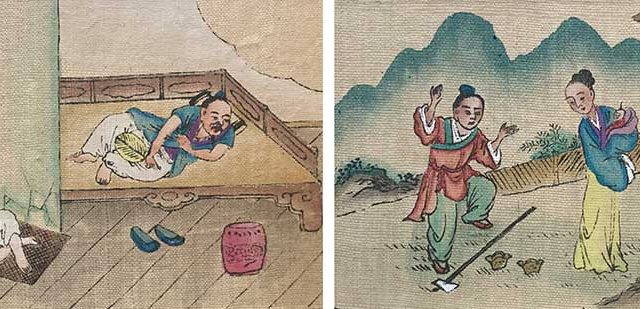To mark Carers Rights Day, I have chosen five examples from the V&A’s South Kensington collections that relate to caregiving.
Caregiving is one of the most essential yet often invisible roles in our society. Whether it’s a parent caring for a child, a neighbour looking after an elderly friend, or a healthcare worker tending to the sick, the act of caregiving has the power to change lives. The annual Carers Rights Day, observed last Thursday (21st November), aims to raise awareness of the rights of caregivers and ensure they receive the support and recognition they deserve. The 2023 Carer’s Leave Act marks a significant step forward, granting employees the legal right to take unpaid leave for caregiving responsibilities. At the V&A, we’re proud to go a step further by offering paid Carer’s Leave, reinforcing our commitment to supporting our staff in balancing work and caregiving.
To honour the spirit of care and compassion, here are five objects from our collections that embody the impact of thoughtful design, healing, and empathy.
1. A ‘braille block’

What: Tactile paving slab
Where: Design 1900-Now, Room 74, V&A South Kensington
The tactile paving slab on display is more than just a piece of design; it’s a testament to human ingenuity and compassion. This innovative technology, pioneered by Japanese inventor Seiichi Miyake in the 1960s, has revolutionised accessibility.
Miyake’s vision was to create a system that would guide the visually impaired safely through urban environments. His invention, the ‘braille block’, or ‘Tenji block’, consists of tactile paving tiles with raised lines or domes that indicate safe walking paths and potential hazards.
The V&A’s collection includes a contemporary version of Miyake’s original design, produced in 2016. This polyurethane tile symbolises the power of design to improve the lives of people with disabilities. By incorporating tactile elements into public spaces, we can create a more inclusive and equitable world for all.
2. Artwork for a children’s hospital ward

What: Tile panel by Margaret E. Thompson
Where: Ceramics, Room 144, V&A South Kensington
The ‘Mary, Mary, Quite Contrary’ tile panel at the V&A is more than just a piece of art; it speaks to the enduring nature of human kindness and the healing properties of beauty. Designed by the British artist Margaret E. Thompson and crafted by Doulton & Co., this colourful ceramic panel would have most likely adorned the wall of a children’s ward in a hospital.
The vibrant colours, playful imagery, and familiar nursery rhyme would have offered a comforting distraction to a young patient, perhaps feeling unwell or scared.
3. A stained glass St. John the Evangelist

What: St. John the Evangelist stained glass panel
Where: Sacred Silver & Stained Glass, Room 84, V&A South Kensington
St. John the Evangelist is considered the Patron Saint of Caregivers as, when Jesus was on the cross, He entrusted His mother, Mary, to the care of John (John 19:26-27). This highlights the importance of providing care and assistance to those who need it.
This stained glass panel, in Room 84, offers a visual representation of St. John’s enduring legacy of compassion and healing. Dating back to the 15th century, it is an exquisite piece of English stained glass that depicts St. John holding a palm branch and a cup from which a dragon emerges.
This imagery is rooted in a fascinating legend. It is said that the enemies of St. John handed him a poisoned cup of wine. However, when St. John made the sign of the cross, the poison transformed into a dragon and fled.
4. A ‘Physic Cup’

What: Wedgwood feeding cup
Where: British Galleries, Room 52a
Josiah Wedgwood, a pioneer of British ceramics, was not only an innovator but also a compassionate businessman. His designs extended beyond the realm of luxury goods to include practical items for everyday use. One such object is the feeding cup – which he called a ‘physic cup’ – a simple yet essential tool that reflects Wedgwood’s commitment to improving the lives of others.
This elegant cream-coloured earthenware feeding cup, produced in Etruria, Staffordshire, was designed to aid individuals with disabilities who struggled to consume solid foods. Its boat-shaped design and elaborate handle make it both functional and aesthetically pleasing.
The delicate depiction of a dog brings a playful charm to this practical object. This whimsical detail serves as a reminder of the importance of human connection and the power of companionship, even in the most challenging of circumstances.
Wedgwood’s feeding cup embodies the spirit of care and innovation. By creating functional and beautiful objects, Wedgwood elevated the everyday, transforming simple acts like feeding into moments of comfort and dignity.
5. A statue of Joshua Ward

What: Joshua Ward sculpture by Agostino Carlini
Where: Sculpture, Room 24
The Englishman Joshua Ward (1685–1761), is a complex and controversial figure of 18th century medical history. Renowned as a “quack doctor” (i.e. someone who professes to be a medical expert, despite no qualifications), he gained both fame and notoriety for his unorthodox practices.
Despite his questionable methods, he made a significant impact through philanthropic endeavours. He established hospitals for the poor, demonstrating a genuine concern for the well-being of those less fortunate. The hospitals provided much-needed care and treatment to those who could not afford it, solidifying his reputation as a benefactor.
However, his practices were often criticised by the medical establishment. Remedies including ‘Ward’s Pill’ and ‘Ward’s Drop’ were considered dubious and potentially harmful – even lethal. Nevertheless, he gained a loyal following, including members of the royal family, who believed in his healing abilities.
Ward’s legacy is a fascinating blend of philanthropy and controversy. While his medical methods may have been questionable, his commitment to caring for the sick and the impoverished remains a testament to his complex character.
By exploring these objects and the stories behind them, we gain a deeper appreciation for the many ways caregiving, compassion, and thoughtful design shape our world. Whether through physical accessibility, artistic healing, or complex legacies of care, these objects remind us that the act of caregiving has the power to transform lives and communities.



A really interesting and thought provoking article. Carers Day deserves to be given a higher profile to reflect its importance in today’s society.
Really interesting to see this varied collection of exhibits brought together under this theme. The museum is so vast that it’s easy to overlook things which are really worthy of attention. I really enjoyed reading this.